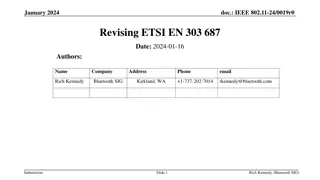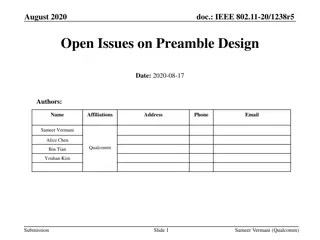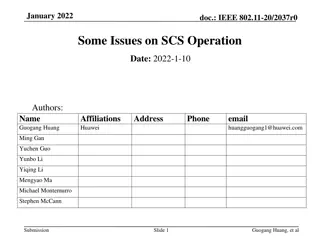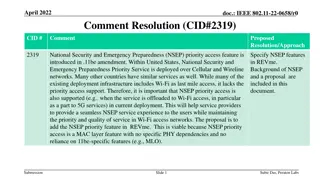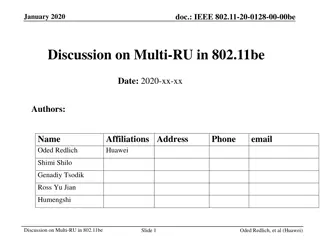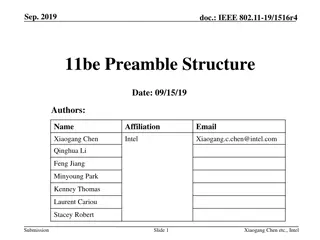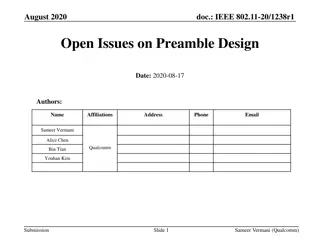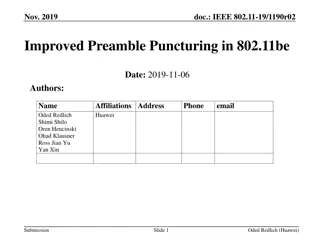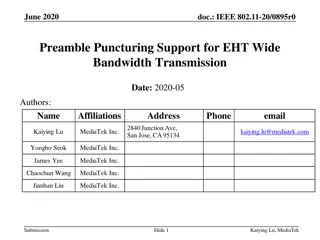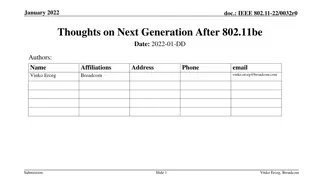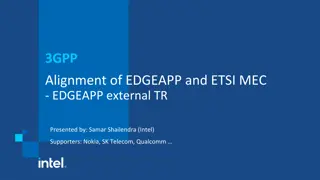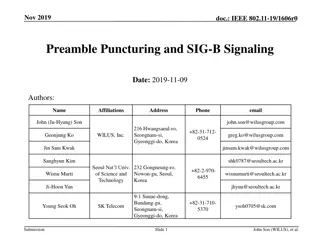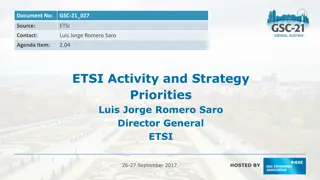Proposal for Reusing ETSI Puncturing Mask in IEEE 802.11be Standard
A proposal is presented in the document IEEE 802.11-20/1165r0 discussing the possibility of reusing the ETSI-defined puncturing mask in the context of the 11be standard. The document highlights the comprehensive nature of the ETSI mask, covering various puncturing cases, and suggests that adopting this mask could prevent unnecessary debates within the IEEE. Details on the ETSI puncturing mask specifications, examples of edge and middle puncturing scenarios in 11be, and the potential benefits of utilizing the established ETSI mask are provided in the submission.
Download Presentation

Please find below an Image/Link to download the presentation.
The content on the website is provided AS IS for your information and personal use only. It may not be sold, licensed, or shared on other websites without obtaining consent from the author. Download presentation by click this link. If you encounter any issues during the download, it is possible that the publisher has removed the file from their server.
E N D
Presentation Transcript
Aug. 2020 doc.: IEEE 802.11-20/1165r0 Spectral Mask for puncturing Date: 08/01/20 Authors Email Xiaogang Chen Xiaogang.c.chen@intel.com Qinghua Li Xinrong Wang Submission Slide 1 Intel
Aug. 2020 doc.: IEEE 802.11-20/1165r0 Background 11ax defined spectral mask for preamble puncture but the mask was considered too relax; ETSI is defining punctured mask in 5GHz[1], which is comprehensive and covered many puncturing cases. Although the puncturing in 6GHz has not been discussed, it will very likely reuse the 5GHz definition. FCC doesn t have a punctured mask definition in 6GHz Only has OOBE mask definition which is the same as the OOBE mask defined in 11ax[2]. Submission Slide 2 Intel
Aug. 2020 doc.: IEEE 802.11-20/1165r0 11be puncturing mask Punctured subchannels in 11be include: 20/40/80MHz either on the edge of the PPDU or within the PPDU. All of the puncturing cases defined in 11be have been covered by the ETSI puncturing mask definition. ETSI punctured mask have been debated and harmonized in ETSI meeting with the participants from both WiFi and cellular sides. Reusing the puncturing mask defined in ETSI can avoid debating again in IEEE. Since it is ETSI mask, vendors need to meet the mask eventually. Propose 11be puncturing mask reuses the puncturing mask defined in ETSI with necessary changes. Submission Slide 3 Intel
Aug. 2020 doc.: IEEE 802.11-20/1165r0 Recap of the ETSI puncturing mask Edge puncturing: Linear interpolation (dB domain) from 0dBr to -20dBr, from 0 to 1MHz frequency offset; Linear interpolation (dB domain) from -20dBr to -28dBr, from 1 to M/2 MHz frequency offset. Middle puncturing >=40MHz: Linear interpolation (dB domain) from 0dBr to -20dBr, from 0 to 1MHz frequency offset; Linear interpolation (dB domain) from -20dBr to -25dBr, from 1 to M/2 MHz frequency offset. Middle puncturing 20MHz: Linear interpolation (dB domain) from 0dBr to -20dBr, from 0 to 1MHz frequency offset; Linear interpolation (dB domain) from -20dBr to -23dBr, from 1 to 10 MHz frequency offset. Submission Slide 4 Intel
Aug. 2020 doc.: IEEE 802.11-20/1165r0 Example of 11be edge puncturing M = 60MHz in this example. Yellow dashed line is the 80MHz SEM (for comparison) 0dBr -20dBr -28dBr -40dBr Freq [MHz] -20.5 -120 -80 -20 39.5 40.5 -50 70 80 120 80MHz PPDU with edge 20MHz punctured Submission Slide 5 Intel
Aug. 2020 doc.: IEEE 802.11-20/1165r0 Example of the 11be middle puncturing (40MHz punctured) M = 40MHz for the left half of the mask; M = 80Hz for the right half of the mask; Yellow dashed line is the 160MHz SEM (for comparison). 0dBr -20dBr -25dBr -28dBr -40dBr Freq [MHz] -80.5 -79.5 -160 -240 79.5 80.5 -0.5 -40 160 240 -39.5 -20 160MHz PPDU with middle 40MHz punctured Submission Slide 6 Intel
Aug. 2020 doc.: IEEE 802.11-20/1165r0 Example of the middle puncturing (20MHz punctured) Yellow dashed line is the 80MHz SEM (for comparison) 0dBr -20dBr -23dBr -28dBr -40dBr Freq [MHz] -40.5 -39.5 -120 -80 39.5 40.5 -0.5 -20 70 80 120 -19.5 80MHz PPDU with middle 20MHz punctured Submission Slide 7 Intel
Aug. 2020 doc.: IEEE 802.11-20/1165r0 Summary ETSI defined comprehensive puncturing rules in 5GHz band already; Propose 11be reuse the rules of subchannel puncturing defined by ETSI with necessary changes. Submission Slide 8 Intel
Aug. 2020 doc.: IEEE 802.11-20/1165r0 SP1 Do you agree with the rule of edge channel puncturing below? When the lowest and/or the highest subchannel(s) is/are punctured in a PPDU, an additional subchannel edge mask as in figure below shall be applied at the lower edge of the lowest occupied subchannel and at the higher edge of the highest occupied subchannel. M is the separation in MHz between the lower edge of the lowest occupied subchannel and the higher edge of the highest occupied subchannel in the PPDU. Punctured subchannel(s) Occupied subchannel(s) 0dBr PSD -20dBr -28dBr Frequency offset (MHz) Relative to the edge of the punctured subchannel(s) M/2 0.5 0 Submission Slide 9 Intel
Aug. 2020 doc.: IEEE 802.11-20/1165r0 SP2 Do you agree with the rule of middle subchannel (>=40MHz) puncturing below? When there are two or more contiguous 20MHz subchannels are punctured in a PPDU, an additional subchannel edge mask as in figure below shall be applied at the lower edge of the lowest punctured subchannel(s) and at the higher edge of the highest punctured subchannel(s). M is the contiguous occupied bandwidth adjacent to the punctured subchannel(s). The lower edge and higher edge each has its own M which can be different. Note: For a frequency that both subchannel edge mask have value greater than -25dBr and less than - 20dBr, the higher value of the two subchannel edge mask shall be taken as the overall mask value. Punctured subchannel(s) Occupied subchannel(s) 0dBr PSD -20dBr -25dBr Frequency offset (MHz) M/2 Relative to the edge of the punctured subchannel(s) 0.5 0 Submission Slide 10 Intel
Aug. 2020 doc.: IEEE 802.11-20/1165r0 SP3 Do you agree with the rule of middle 20MHz channel puncturing below? When the puncturing only includes one 20MHz subchannel and the punctured 20MHz subchannel is not at the edge of the PPDU, an additional mask as in figure below shall be applied at the punctured 20MHz subchannel. Punctured subchannel Occupied subchannel(s) Occupied subchannel(s) PSD -20dBr -23dBr Frequency offset (MHz) Relative to the edge of the punctured subchannel 19.5 10 20 0.5 0 Submission Slide 11 Intel
Aug. 2020 doc.: IEEE 802.11-20/1165r0 Reference [1] ETSI EN 301 893 V2.1.3519 (202019-0410) [2] Unlicensed Use of the 6 GHz Band - Report and Order and Further Notice of Proposed Rulemaking. Submission Slide 12 Intel











